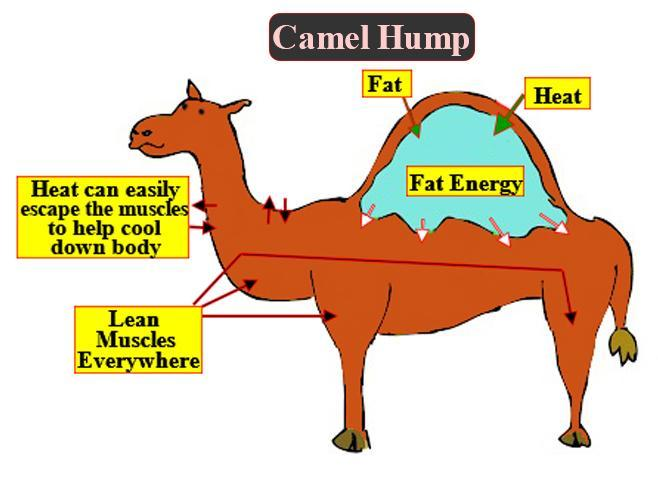
The camel’s hump is made of which tissues?
(a) Skeletal
(b) Muscular
(c) Areolar
(d) Adipose
Answer
492k+ views
Hint: The camel’s hump is made of the fat tissues. It helps in the insulation of their body and additionally, it helps in obtaining the energy when there is a lack of food and in unfavorable conditions.
Complete answer:
Camel hump is made from the fatty adipose tissue. Adipose tissue is body fat, which is a type of loose connective tissue composed of adipocyte (fat cells). Adipose tissue is obtained from preadipocytes. And the main role of the adipocyte is to store energy in the form of lipids. It will act as cushions and insulate the body. This concentrated fat will minimize the heat-trapping all through the other body parts. When the fat tissue gets metabolized, it will get converted into the energy and also will yield nearly one gram of water (i.e.,) if one gram of fat gets broken down during the process of metabolism, it will produce more than one gram of water.
Camels are extensively found in the desert, where the sources of food are minimal. When a camel couldn’t find its food for a long time period, then its body can metabolize the fat present in the humps for obtaining the necessary nutrition. The humps will deflate and will droop if the camel doesn’t find food for a very long time. However, they will become upright once the camel takes its food. The camel’s hump will help in regulating the camel’s body temperature, which is a crucial feature in the desert, where the temperatures will be extremely high in the day and will be extremely low at night. The heat of the body can be lessened by concentrating the fatty tissue in the humps region of the camel’s back when the temperature is high during the day, and their body temperature rises. Then, during the night, the extra heat dissipates through the rest of the camel’s body so that their body temperature is not too low when the temperature is cooler.

So, the correct answer is ‘Adipose tissue’.
Note: The fine woolly coat of the camel insulates the body and thereby decreases heat gain. The camel will also cause its body temperature to rise to 106 ° F (41 ° C) before any sweating. This reduces the difference in temperature between the camel and its surroundings and thereby decreases heat gain and water loss by as much as two thirds.
Complete answer:
Camel hump is made from the fatty adipose tissue. Adipose tissue is body fat, which is a type of loose connective tissue composed of adipocyte (fat cells). Adipose tissue is obtained from preadipocytes. And the main role of the adipocyte is to store energy in the form of lipids. It will act as cushions and insulate the body. This concentrated fat will minimize the heat-trapping all through the other body parts. When the fat tissue gets metabolized, it will get converted into the energy and also will yield nearly one gram of water (i.e.,) if one gram of fat gets broken down during the process of metabolism, it will produce more than one gram of water.
Camels are extensively found in the desert, where the sources of food are minimal. When a camel couldn’t find its food for a long time period, then its body can metabolize the fat present in the humps for obtaining the necessary nutrition. The humps will deflate and will droop if the camel doesn’t find food for a very long time. However, they will become upright once the camel takes its food. The camel’s hump will help in regulating the camel’s body temperature, which is a crucial feature in the desert, where the temperatures will be extremely high in the day and will be extremely low at night. The heat of the body can be lessened by concentrating the fatty tissue in the humps region of the camel’s back when the temperature is high during the day, and their body temperature rises. Then, during the night, the extra heat dissipates through the rest of the camel’s body so that their body temperature is not too low when the temperature is cooler.

So, the correct answer is ‘Adipose tissue’.
Note: The fine woolly coat of the camel insulates the body and thereby decreases heat gain. The camel will also cause its body temperature to rise to 106 ° F (41 ° C) before any sweating. This reduces the difference in temperature between the camel and its surroundings and thereby decreases heat gain and water loss by as much as two thirds.
Recently Updated Pages
Master Class 12 Social Science: Engaging Questions & Answers for Success

Class 12 Question and Answer - Your Ultimate Solutions Guide

Class 10 Question and Answer - Your Ultimate Solutions Guide

Master Class 10 Science: Engaging Questions & Answers for Success

Master Class 10 Maths: Engaging Questions & Answers for Success

Master Class 9 General Knowledge: Engaging Questions & Answers for Success

Trending doubts
Is Cellular respiration an Oxidation or Reduction class 11 chemistry CBSE

In electron dot structure the valence shell electrons class 11 chemistry CBSE

What is the Pitti Island famous for ABird Sanctuary class 11 social science CBSE

State the laws of reflection of light

One Metric ton is equal to kg A 10000 B 1000 C 100 class 11 physics CBSE

Difference Between Prokaryotic Cells and Eukaryotic Cells




